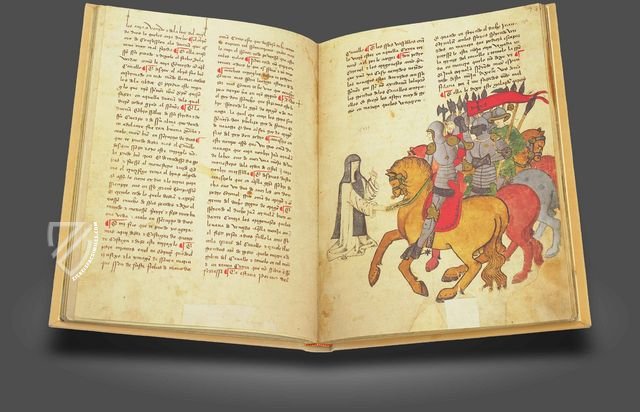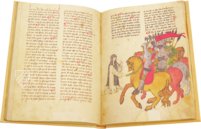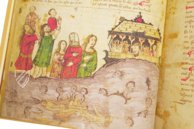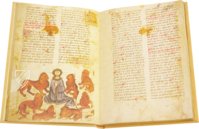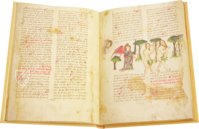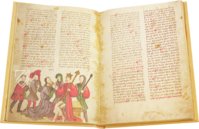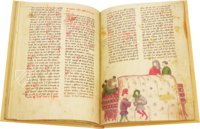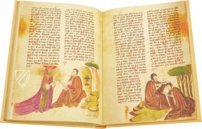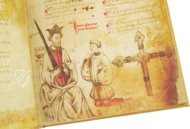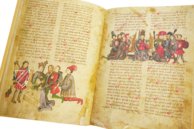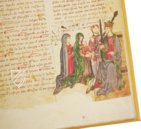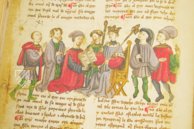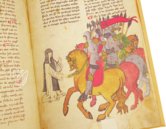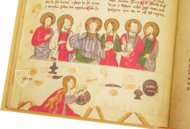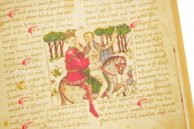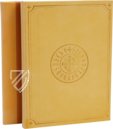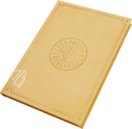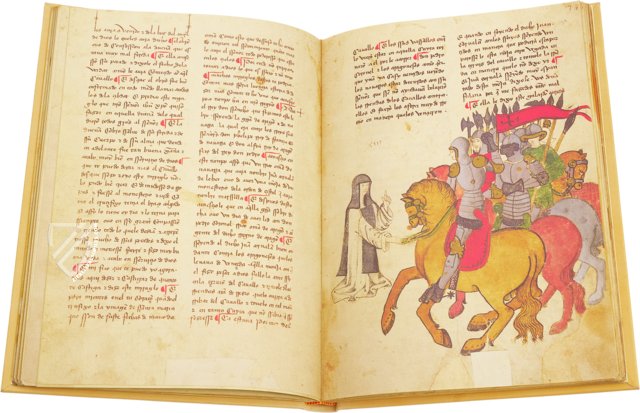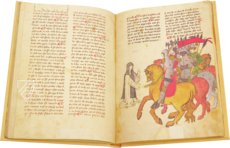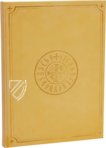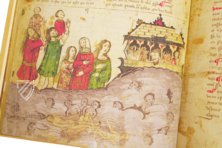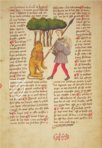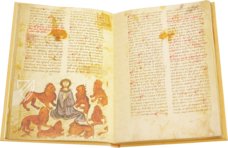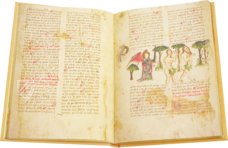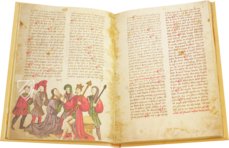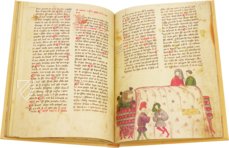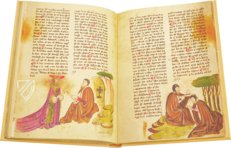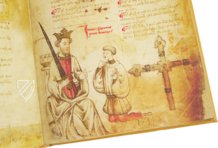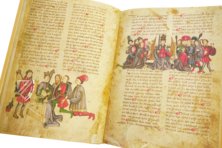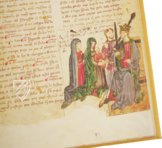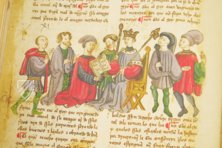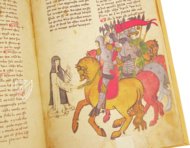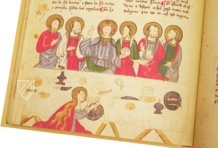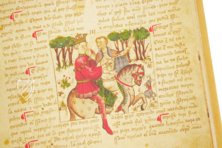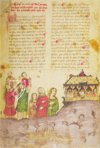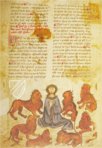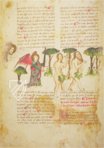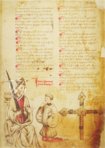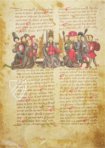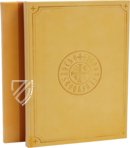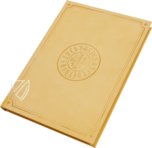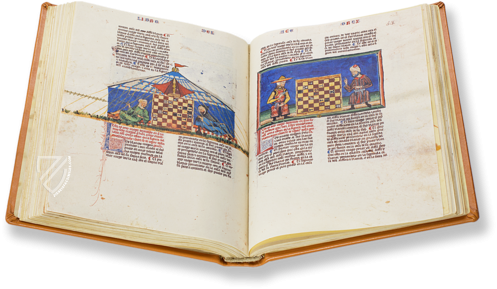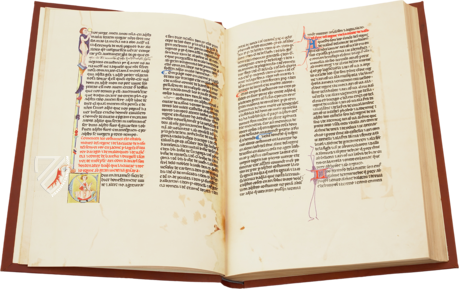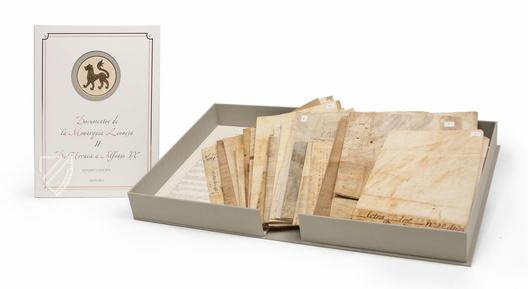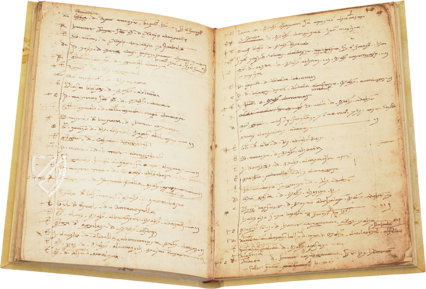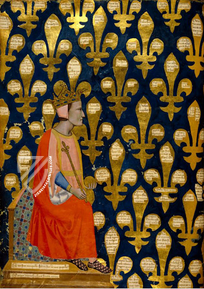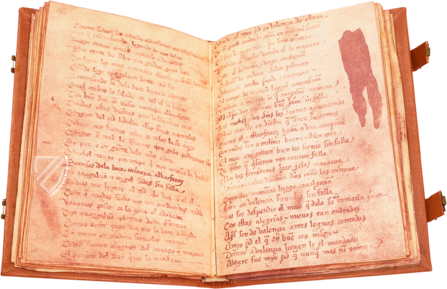The Book of Punishment and Documents of King Sancho IV the Brave
(1,000€ - 3,000€)
How was one expected to lead a virtuous life in the Middle Ages? Those wanting to inform themselves on the matter can take a look at the Book of Punishment of King Sancho IV “the Brave” of Castile. The artfully illuminated manuscript likely originated in the scriptorium of his father, Alfonso X “the Wise”, and was then completed in his son’s name “…with the help of wise scholars”. It contains legends told by saints and prophets that are meant to instruct the reader – a king – how he should behave toward God, himself, and his subjects. The precious manuscript was completed in 1292 and contains 22 miniatures in muted colors, some of which are furnished in precious gold leaf. They are a precious and entertaining source concerning life during King Sancho’s reign depicting both armored knights on horseback and the everyday lives of the common folk.
The Book of Punishment and Documents of King Sancho IV the Brave
The special codex with the translated title The Book of Punishment and Documents for a Better Life is an exemplary text for the didactic and moralizing literature of the 13th century. It consists of sermons and apologetic texts from various clerical and heathen sources. The book was dedicated to Sancho IV – called “the Brave” – the King of Castile and his son Ferdinand IV. The moralizing stories in the work are supposed to teach the reader good manners as well as how one should behave toward God, themselves, and one’s subjects. An inscription on the last page of the codex indicates that the work was authored in the name of Sancho IV. Here it states that editing of the work was completed in 1292 and that it was composed “…with the help of wise scholars”. The book probably originated in the scriptorium of the King’s father Alfonso X the Wise.
The Spanish Royal House’s Love of Books
Sancho IV was as big of a literary buff as his father Alfonso X. Both accumulated a comprehensive and incomprehensibly valuable book collection during their lives. Alongside the Book of Punishment, Sancho had two great encyclopedias translated. Those were the Book of Treasures by Brunetto Latini in 1293 followed two years later by the lexicon Elucidarium by Honorius of Autun. Between 1284 and 1289, a chronology of the history of Spain was composed in Sancho’s name. This was considered to be a reliable historical source in the Middle Ages, like the Book of Punishment. Today, it is clear that some of the depictions in these works do not completely reflect reality. Nevertheless, they inform us in an entertaining way about life under the great King Sancho the Brave.
Informative and Expressive Illustration
The Book of Punishment points to various tales about how one behaved ethically in medieval Spain. The particularly illustrious Chapter XI contains a wondrous legend from the life of the prophet Daniel. In this chapter, it is elucidated how vassals should fittingly honor their masters. The gifted illuminator Beatus of Saint-Sever painted a scene of the Daniel and a Lion. The prophet is not attacked by the lion, as one expects. The legend is supposed to teach, that nothing bad can happen to those who serve the Lord. For his illustrations, the artist Beatus only used a few primary colors, but realized an unbelievably creative effect. An image on page 85 of the Book of Punishment is supposed to have inspired Picasso for his painting Guernica. The miniatures of the work are extremely diverse and show armored knights on horseback, but also typical people in medieval robes. One sees starry night skies in a few pictures, in others the earth hills and mountains overgrown with green, and in others the sea with fish and ships.
Codicology
- Alternative Titles
- The Book of Punishment and Documents of King Sancho IV
Castigos e Documentos de Sancho IV el Bravo
Castigos e Documentos de Sancho IV
El Libro de los Castigos e documentos para bien vivir
Buch der Strafen und Dokumente von König Sancho dem Tapferen - Size / Format
- 166 pages / 37.0 × 26.5 cm
- Origin
- Spain
- Date
- Around 1290
- Epochs
- Style
- Genre
- Language
- Illustrations
- 22 miniatures of various sizes, some containing gold
- Content
- Legends by saints and prophets
- Patron
- Sancho IV the Brave, King of Castile (1258–1295)
- Artist / School
- Royal scriptorium of Toledo
- Previous Owners
- Ferdinand IV
Book of Simple Medicines
Expulsion from Paradise
The original sin brought about the original punishment – Adam and Eve are shown being expelled from the Garden of Eden by an angel armed with a sword for defying God’s explicit ban on eating fruit from the tree of knowledge. As the deceitful snake wraps itself around a tree in the background, the first humans are scurrying away while covering their shameful nudity with large leaves. On the left, God’s angry face is shown emerging from the clouds, his wrath represented by wind.
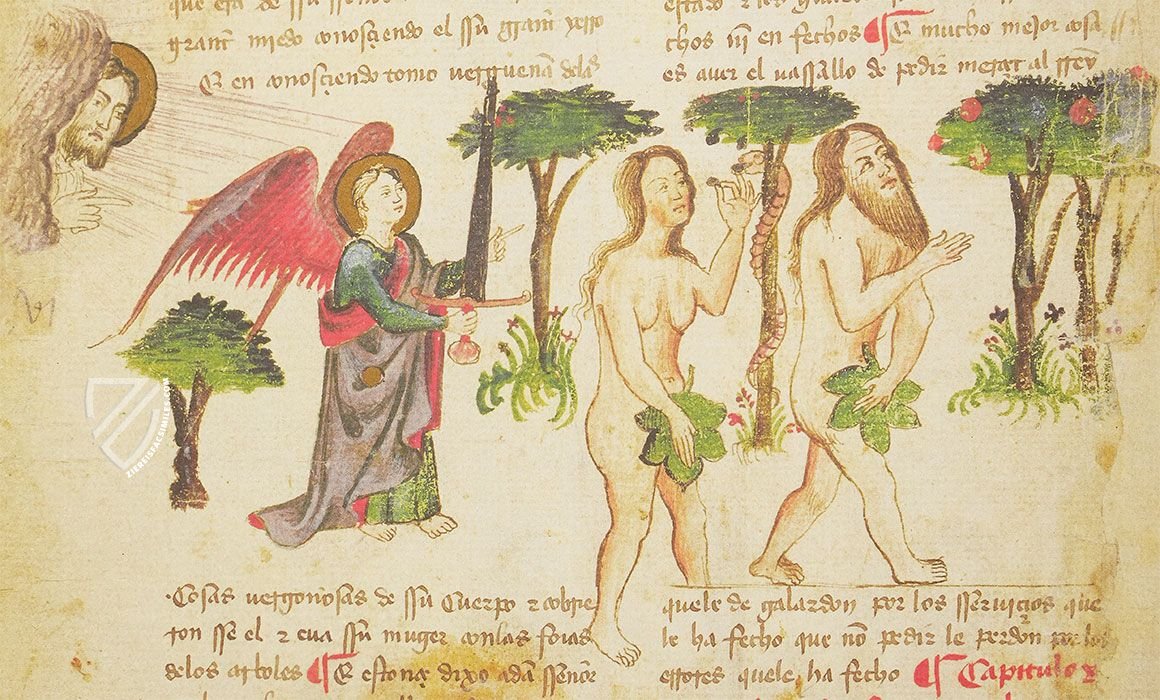
The Book of Punishment and Documents of King Sancho IV the Brave
Sign of King Don Sancho
This is a perfectly composed example of Spanish Gothic illumination and is dominated by brilliant shades of red and blue ennobled with gold leaf. Surrounding the King’s coat of arms, an inscription reads Signo del Rey Don Sancho and is presented in the style of a cathedral’s rose window. King Sancho IV is seated on the left in blue brocade and is flanked by his counselors.
A cardinal, likely the patron, is seated across from the King before a group of tonsured men representing the “wise scholars” responsible for the work. The miniature simultaneously depicts both the interior and exterior of the building, showing the tiled roof and pointed arch windows on the outside at the same time as showing the vaulted roof and columns inside.
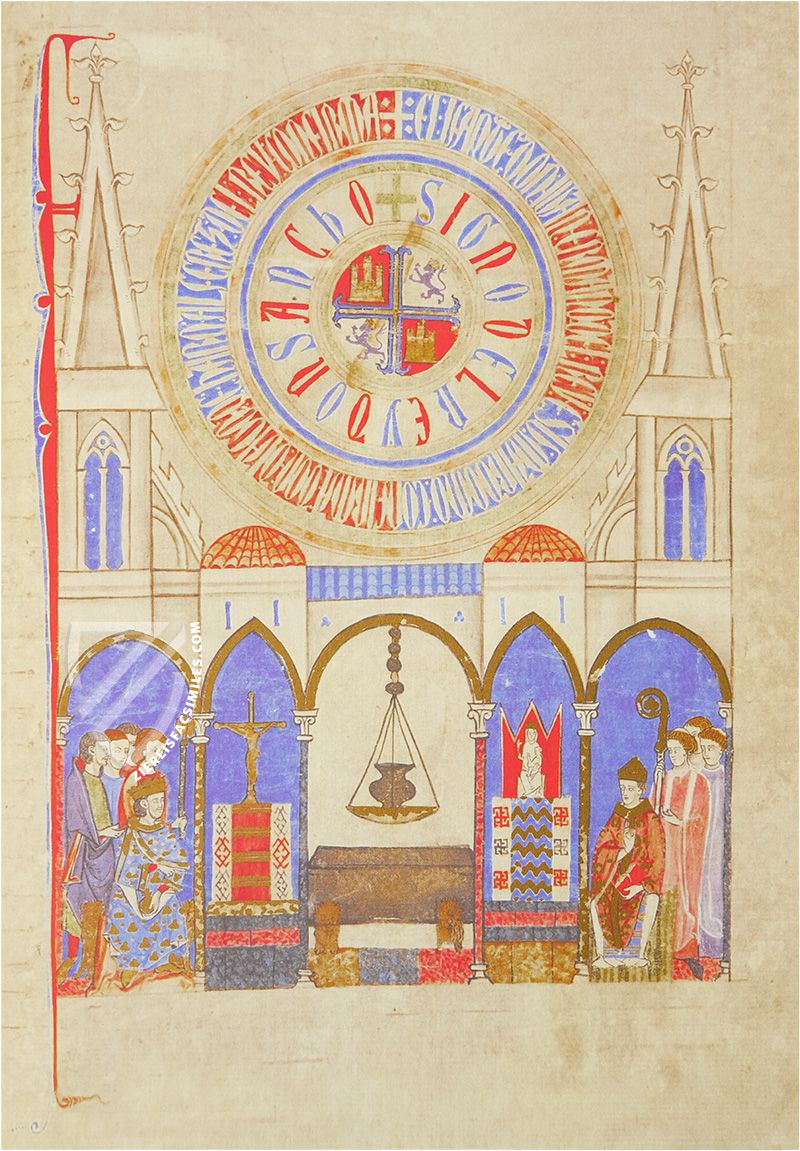
#1 Castigos e Documentos de Sancho IV el Bravo
Language: Spanish
(1,000€ - 3,000€)
- Treatises / Secular Books
- Apocalypses / Beatus
- Astronomy / Astrology
- Bestiaries
- Bibles / Gospels
- Chronicles / History / Law
- Geography / Maps
- Saints' Lives
- Islam / Oriental
- Judaism / Hebrew
- Single Leaf Collections
- Leonardo da Vinci
- Literature / Poetry
- Liturgical Manuscripts
- Medicine / Botany / Alchemy
- Music
- Mythology / Prophecies
- Psalters
- Other Religious Books
- Games / Hunting
- Private Devotion Books
- Other Genres
- Afghanistan
- Armenia
- Austria
- Belgium
- Colombia
- Croatia
- Czech Republic
- Denmark
- Egypt
- Ethiopia
- France
- Germany
- Hungary
- India
- Iran
- Iraq
- Israel
- Italy
- Japan
- Luxembourg
- Mexico
- Morocco
- Netherlands
- Peru
- Poland
- Portugal
- Russia
- Serbia
- Spain
- Sri Lanka
- Sweden
- Switzerland
- Syria
- Turkey
- Ukraine
- United Kingdom
- United States
- Uzbekistan
- Aboca Museum
- Ajuntament de Valencia
- Akademie Verlag
- Akademische Druck- u. Verlagsanstalt (ADEVA)
- Aldo Ausilio Editore - Bottega d’Erasmo
- Alecto Historical Editions
- Alkuin Verlag
- Almqvist & Wiksell
- Amilcare Pizzi
- Andreas & Andreas Verlagsbuchhandlung
- Archa 90
- Archiv Verlag
- Archivi Edizioni
- Arnold Verlag
- ARS
- Ars Magna
- ArtCodex
- AyN Ediciones
- Azimuth Editions
- Badenia Verlag
- Bärenreiter-Verlag
- Belser Verlag
- Belser Verlag / WK Wertkontor
- Benziger Verlag
- Bernardinum Wydawnictwo
- BiblioGemma
- Biblioteca Apostolica Vaticana (Vaticanstadt, Vaticanstadt)
- Bibliotheca Palatina Faksimile Verlag
- Bibliotheca Rara
- Boydell & Brewer
- Bramante Edizioni
- Brepols Publishers
- British Library
- C. Weckesser
- Caixa Catalunya
- Canesi
- CAPSA, Ars Scriptoria
- Caratzas Brothers, Publishers
- Carus Verlag
- Circulo Cientifico
- Club Bibliófilo Versol
- Club du Livre
- CM Editores
- Collegium Graphicum
- Collezione Apocrifa Da Vinci
- Comissão Nacional para as Comemorações dos Descobrimentos Portugueses
- Coron Verlag
- Corvina
- CTHS
- D. S. Brewer
- De Agostini/UTET
- De Schutter
- Deuschle & Stemmle
- Deutscher Verlag für Kunstwissenschaft
- DIAMM
- Droz
- E. Schreiber Graphische Kunstanstalten
- Ediciones Boreal
- Ediciones Grial
- Ediclube
- Edições Inapa
- Edilan
- Editalia
- Edition Georg Popp
- Edition Leipzig
- Edition Libri Illustri
- Editiones Reales Sitios S. L.
- Éditions de l'Oiseau Lyre
- Editions Medicina Rara
- Editorial Casariego
- Editorial Mintzoa
- Editrice Antenore
- Editrice Velar
- Edizioni Edison
- Egeria, S.L.
- Eikon Editores
- Electa
- Enciclopèdia Catalana
- Eos-Verlag
- Ephesus Publishing
- Eugrammia Press
- Extraordinary Editions
- Fackelverlag
- Facsimila Art & Edition
- Facsimile Editions Ltd.
- Facsimilia Art & Edition Ebert KG
- Faksimile Verlag
- Feuermann Verlag
- Folger Shakespeare Library
- Franco Cosimo Panini Editore
- Friedrich Wittig Verlag
- Fundación Hullera Vasco-Leonesa
- G. Braziller
- Gabriele Mazzotta Editore
- Gebr. Mann Verlag
- Gesellschaft für graphische Industrie
- Getty Research Institute
- Giovanni Domenico de Rossi
- Giunti Editore
- Graffiti
- Grafica European Center of Fine Arts
- Guido Pressler
- Guillermo Blazquez
- H. N. Abrams
- Harrassowitz
- Helikon
- Hendrickson Publishers
- Henning Oppermann
- Herder Verlag
- Hes & De Graaf Publishers
- Hoepli
- Hortus Deliciarum
- Houghton Library
- Hugo Schmidt Verlag
- Idion Verlag
- Il Bulino, edizioni d'arte
- ILte
- Imago
- Insel Verlag
- Instituto de Estudios Altoaragoneses
- Instituto Nacional de Antropología e Historia
- Istituto dell'Enciclopedia Italiana - Treccani
- Istituto Ellenico di Studi Bizantini e Postbizantini
- Istituto Geografico De Agostini
- Istituto Poligrafico e Zecca dello Stato
- Italarte Art Establishments
- J. Thorbecke
- Jan Thorbecke Verlag
- Johnson Reprint Corporation
- Jugoslavija
- Karl W. Hiersemann
- Kasper Straube
- Kaydeda Ediciones
- Konrad Kölbl Verlag
- Kurt Wolff Verlag
- La Liberia dello Stato
- La Linea Editrice
- La Meta Editore
- Lambert Schneider
- Landeskreditbank Baden-Württemberg
- Leo S. Olschki
- Les Incunables
- Library of Congress
- Libreria Musicale Italiana
- Lichtdruck
- Lito Immagine Editore
- Lumen Artis
- Lund Humphries
- M. Moleiro Editor
- Maison des Sciences de l'homme et de la société de Poitiers
- Manuscriptum
- Maruzen-Yushodo Co. Ltd.
- MASA
- McGraw-Hill
- Militos
- Millennium Liber
- Müller & Schindler
- National Library of Wales
- Neri Pozza
- Nova Charta
- Oceanum Verlag
- Odeon
- Orbis Mediaevalis
- Orbis Pictus
- Österreichische Staatsdruckerei
- Oxford University Press
- Pageant Books
- Parzellers Buchverlag
- Patrimonio Ediciones
- Pattloch Verlag
- PIAF
- Pieper Verlag
- Plon-Nourrit et cie
- Prestel Verlag
- Princeton University Press
- Prisma Verlag
- Priuli & Verlucca, editori
- Pro Sport Verlag
- Propyläen Verlag
- Pytheas Books
- Quaternio Verlag Luzern
- Reales Sitios
- Recht-Verlag
- Reichert Verlag
- Reichsdruckerei
- Riehn & Reusch
- Roberto Vattori Editore
- Rosenkilde and Bagger
- Roxburghe Club
- Salerno Editrice
- Sarajevo Svjetlost
- Schöck ArtPrint Kft.
- Scolar Press
- Scrinium
- Scripta Maneant
- Scriptorium
- Siloé, arte y bibliofilia
- SISMEL - Edizioni del Galluzzo
- Sociedad Mexicana de Antropología
- Sorli Ediciones
- Stainer and Bell
- Styria Verlag
- Sumptibus Pragopress
- Szegedi Tudomànyegyetem
- Taberna Libraria
- Tarshish Books
- Taschen
- Tempus Libri
- Testimonio Compañía Editorial
- Thames and Hudson
- The Clear Vue Publishing Partnership Limited
- The Facsimile Codex
- The Folio Society
- The Marquess of Normanby
- The Richard III and Yorkist History Trust
- Tip.Le.Co
- TouchArt
- TREC Publishing House
- TRI Publishing Co.
- Trident Editore
- Typis Regiae Officinae Polygraphicae
- Universidad de Granada
- University of California Press
- University of Chicago Press
- Urs Graf
- Vallecchi
- Van Wijnen
- VCH, Acta Humaniora
- VDI Verlag
- Verlag für Regionalgeschichte
- Verlag Styria
- Vicent Garcia Editores
- W. Turnowsky
- Wiener Mechitharisten-Congregation (Wien, Österreich)
- Wissenschaftliche Buchgesellschaft
- Xuntanza Editorial
- Zollikofer AG

